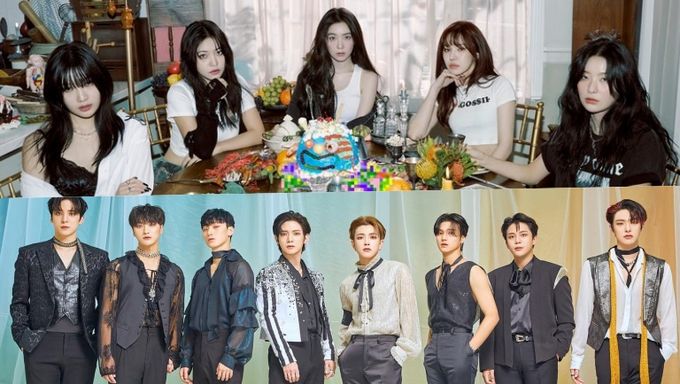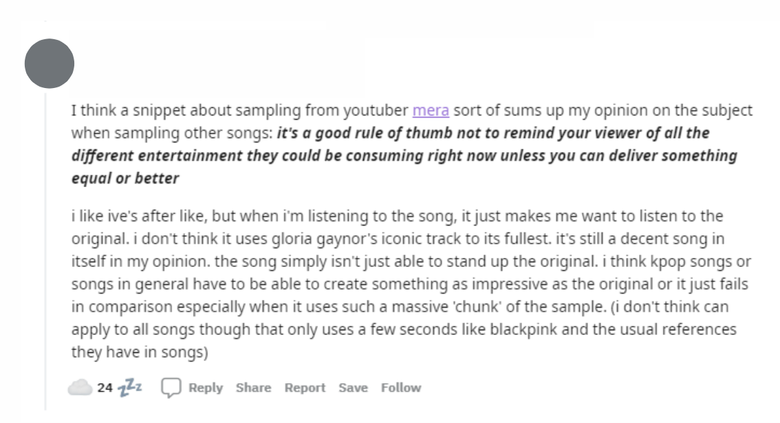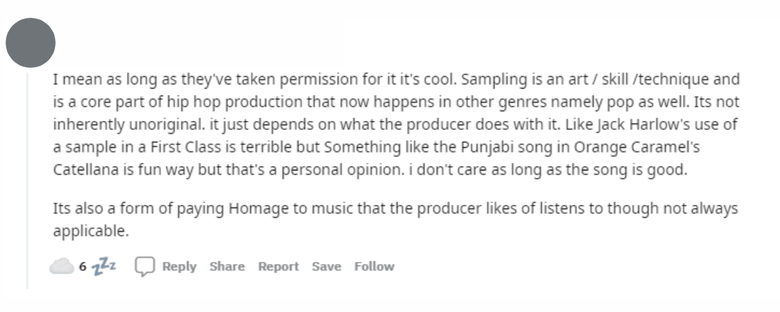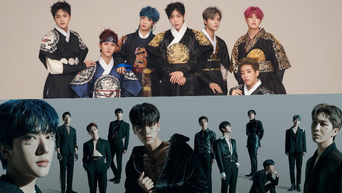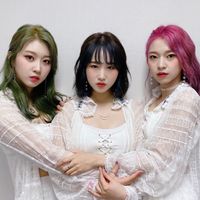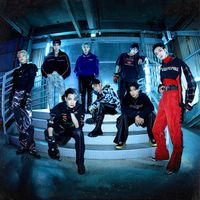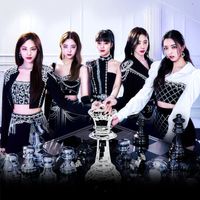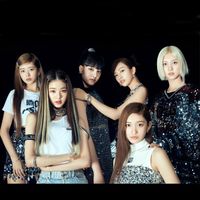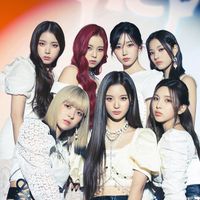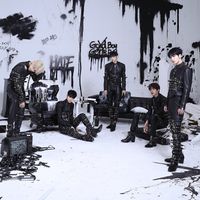Whilst the use of samples and interpolation has been consistent in K-Pop over the years, the past couple of years have definitely seen an increase in more and more blatant intertwines of other music. Have you noticed an increase in K-Pop songs that sound familiar/similar by your favorite K-Pop artists these days? Today, we’ll delve into understanding more about where this familiarity stems from in this article.
The generally experimental nature of K-Pop
K-Pop is known as a genre that is open to ideas. “K-Pop is all about experimentalism. You can go from super bubblegummy pop one minute to a hardcore breakdown the next second. Most K-Pop fans won’t even blink at this point.”
- “Explained” series, K-Pop episode In this case, samples and interpolations originally generate from the hip-hop music culture. Hip-hop was the only genre to use these music production techniques for a long period of time before the methods were adopted by pop music and K-Pop, as well. They are both considered experimental music production tools that mix nostalgia with fresh originality. K-Pop, in particular, is known as an already highly-experimental genre; which allows room for all sorts of common and uncommon music production techniques. In order to understand musical trends in K-Pop, one must acknowledge its experimentality. For example, one of the key traits of a K-Pop song can be how it contains more than one genre in one track. This might be disorientating for first-time listeners, however, once you adjust your ear to the K-Pop style, you will realize that it breeds room for creativity. For example, one of the best-known experimental 2nd generation K-Pop songs is ‘I Got A Boy’ by Girls’ Generation (2013). When the song first came out, many fans felt that it sounded ‘discombobulated’ and could’ve been divided into more than one song. The song supposedly has 9 moments where different genres come together to create a new and infused sound. It starts with a hip-hop foundation and moves to pop-rock. then has an EDM break, and so forth. The same applies to a song like ‘BAE BAE’ by BIGBANG (2015) which starts with the trap genre, transitions to folk, and has a ballad portion, too. In more recent years, groups such as JYP Entertainment’s ITZY and NMIXX have also become known for their experimental sound and are clear evidence of the progression that exploration in K-Pop music production has made through the use of several elements within a single song. One of the ways that K-Pop has been experimenting over the years and even more recently, is through the inclusion of samples and interpolations. Hidden between these layers of experimentation, there are sounds that are familiar to the avid music lover and K-Pop consumer. Let’s take a look at how these music production techniques have become part of K-Pop’s creative experiment.
Samples vs. Interpolation: Differences and examples
Samples and interpolations are often mistaken for each other.
What is a sample?
Sampling is when you include an element of a pre-existing recording by another artist in your song. This sampled element can be anything from the rhythm, melody, vocals, beat, etc. that you edit into your song.
Examples of samples in K-Pop - the latest renaissance classical music trend
There are many examples of samples used in K-Pop, however, today we’ll focus on the use of classical music samples as a mini case study. K-Pop has made use of classical music throughout the years, however, in recent years it seems that this has become a renaissance in itself as the classical music genre keeps being revived through K-Pop. It is not to say that classical music is dead - it isn’t, but it is definitely gaining a renewed form of attention through modern pop culture. Red Velvet has been gaining a lot of attention for its conscious effort to use classical music in its 2022 comebacks. Their 2022 hit song ‘Feel My Rhythm’ used a sample from Johann Sebastian Bach’s Orchestral Suite No. 3 in D Major BWV 1068/August Wilhelmj’s 1871 ‘Air On The G String’ arrangement. Not only did the music video have various classic art motifs in the imagery, but the song itself felt like a renaissance melody. The homage to Bach was especially evident as the song was even released on his birthday (Mar. 21). The song had a huge impact as not only was it lovely to listen to, but many K-Pop fans became curious about classical music after the release. Their most recent comeback with the title song ‘Birthday’ (2022) also made use of another classical piece, George Gershwin’s ‘Rhapsody In Blue’ (1924). Additionally, ATEEZ’s epic ‘Symphony No. 9 (From The Wonderland)’ (2021) made use of a rearrangement of Antonín Dvořák’s ‘Symphony No. 9 (From the New World)’ (1893) with their song ‘WONDERLAND’. They performed the musical masterpiece on the Mnet program “Kingdom: Legendary War”. The song matched exceptionally well with emphasizing the theme of the performance. The original piece by Dvořák has multicultural influences from native American and African-American spiritual music which the composer studied when creating the piece, adding depth to its creation. As ATEEZ is well-known for its pirate concept and the adventurous spirit of its music, the classical music piece and its influences really intensified the feeling of going on a quest in its song and performance. The songs mentioned above are the perfect example of how samples can amplify and deepen the listener’s experience of fresh music within the K-Pop genre. Not to mention that the mostly youthful target audience of K-Pop becomes more exposed to the classics and fundamentals of music as a result.
What is interpolation?
Interpolation is an alternative method of using existing music in a new song. Interpolation (in music) refers to using the melody or part of the melody from a previously recorded song and re-recording it with the artist’s own voice. This is different from sampling which simply uses the existing piece of music by the original artist. It can be a verbatim recreation or the artist may decide to change the general rhythm or rhyme compared to the original
Examples of interpolations used in popular K-Pop songs
‘HOT PINK’ by EXID (2016) uses the line, “I like the way you pink it” in the intro, which is actually an interpolation of the lyrics and melody of Missy Elliott’s line, “I like the way you work it.” The line comes from Missy Elliott’s legendary song ‘Work It’ (2002). For a more recent example, some of the most iconic interpolations of K-Pop this year can be found in BLACKPINK’s rap in ‘Pink Venom’ (2022) where they use iconic bit parts from numerous songs. Interpolations included in BLACKPINK’s ‘Pink Venom’:
Rihanna - ‘Pon De Replay’ (2005) Nas - ‘Made You Look’ (2002) Junior M.A.F.I.A - ‘Get Money’ (1995) Notorious B.I.G - ‘Kick in the Door’ (2007) 50 Cent - ‘P.I.M.P’ (2003) Method Man - ‘Bring the Pain’ (1994)
Some of these interpolations were more subtle than others and most of them originate from legendary hip-hop artists, meaning that only a lover of that genre or someone with wide music knowledge would easily be able to detect them.
Implications of these music production techniques
What does the use of samples and interpolations in K-Pop mean?
The increased use of samples and interpolations in K-Pop has not only created a new familiarity with K-Pop but also an air of similarity within the genre. For example, fans were surprised when TXT ‘Blue Hour’ (Oct. 2020) and 3YE ‘Stalker’ (Apr. 2021) were discovered to be from the same sample. Fans noted how the sample was the same with just slight changes in pitch and speed. However, this caused a bit of a stir between both fandoms as the comebacks were so close in proximity. Some fans questioned whether 3YE had simply covered TXT’s song or plagiarized it, not realizing that both groups had just made use of the same sample. For fans who are unfamiliar with the concept of sampling or even using interpolations, there might be some misunderstandings that arise. On the contrary, using the same sample doesn’t always mean that the songs will sound the same. For example, Teen Top’s ‘What’s Problem’ (2017), Jamie ft. PENTAGON’s Kino, WOODZ, and Nathan’s ‘PUTP (Pick Up The Phone)’ (2018), and DREAMCATCHER’s ‘PIRI’ (2019) all use the same sample but the songs all sound extremely different. The sample is ‘Whistle 01 (Dm) 85bpm’ by KSHMR. Each song is a different genre which changes the way that the sample sounds completely. Thus, even though the use of the same sample might cause Deja Vu, the songs don’t necessarily have any impact on each other despite being released one year apart.
Fans’ opinions on the rising trend in K-Pop songs created by these music production techniques
The conversation about sampling has become prevalent among fans with the increase in this trend. Whilst some fans feel that the use of samples can be creative and add a fresh twist to a song, others feel that it is a shortcut in music production that lacks originality. Some fans have used the word ’lazy’ to describe the use of samples, especially when the song relies heavily on the sample and doesn’t just use it as a component. Others feel that sampling gives new life to older songs and allows more people to discover the original music. We asked Kpopmap readers their opinions on K-Pop artists who sample music in their songs on Kpopmap’s Official Reddit Account. Here are some of their responses. Whilst many fans enjoy the nostalgia that comes with sampling music in newer songs, one fan pointed out how the problem with sampling is indeed the fact that it reminds the viewer of another song. For example, IVE’s ‘After Like’ (2022) is one of the most blatant K-Pop samples that makes use of Gloria Gaynor’s ‘I Will Survive’ (1978). However, this fan feels like the highly-recognizable sample intertwined in this K-Pop song does not live up to the legendary status of the original despite its own success. This next fan agrees with the above fan, citing that one might as well listen to the original song since there is a little original twist to the K-Pop song. However, they raise the argument that songs that dissect the sample and reinvent it, create a new listening experience that feels right. One fan focuses on the fact that sampling is a long-standing technique in music production, hence it isn’t inherently unoriginal. It depends on the execution and can be a great way for artists to pay homage to one another. In the same way, another fan felt that artists who use samples and interpolations are simply gaining inspiration to create more art. Although the topic has mixed responses, one common factor in most answers is that sampling and interpolations are okay as long as they are well done. More than the music production technique used, fans seem to care about the execution of the final song. What do you think about the use of samples and interpolations in K-Pop? Do you think that familiar/similar sounds in K-Pop are harmless or do you have another opinion? Let us know in the comments! How K-Pop Music Is Produced: Here’s Everything You Need To Know KPOP STORIES|Aug 18, 2022 Fans Debate The Shift In Popularity From Boy Groups To Girl Groups In Recent K-Pop Fan Culture KPOP STORIES|Nov 16, 2022 The Evolution Of K-Pop Girl Group Concepts Over The Years: From Cute To Girl Crush, And Everything In Between KPOP STORIES|Oct 14, 2022 How K-Pop Marketing Trends Have Changed Over The Years Using Boy Groups As A Case Study FANBUZZ|Jun 8, 2022
